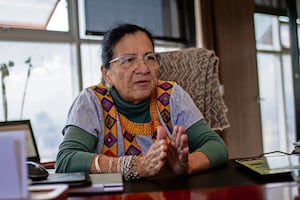Más Información

México y EU llegan a un acuerdo sobre Tratado de Aguas; no se ha violado ninguna disposición, dice gobierno mexicano

FGR acusa a María Amparo Casar de uso ilícito de atribuciones por pensión vitalicia; comparecerá en el reclusorio Oriente

“No está en riesgo el derecho a la información”, asegura Nashieli Ramírez Hernández, secretaria general de la Contraloría de la CDMX

Fátima Bosch, Miss Universo 2025, visitará la torre oncológica del Hospital del Niño en Tabasco; regalará juguetes a los menores con cáncer y VIH
A shelter for migrants , located right in front of the wall that divides Mexico and the United States , has become a tourist attraction for travelers who are willing to pay a tour guide to take them to the shelter and guarantee their access to the facilities where children, women, and men are sheltered after fleeing poverty and violence in Central America .
In recent days, a group of foreign tourists was standing outside a shelter, carrying their cameras , as if the migrant shelter was a tourist attraction .
The “tour guide”, a former Colombian reporter , tells them that this is a shelter for deported migrants but also for those who are in transit, that the shelter is run by a woman named María Luisa, and that she has supported the cause for several years.
They ring the bell and a migrant lets them in. As they enter the shelter , the group starts taking dozens of pictures of the migrants living in the shelter, who in most cases lack basic services, clean clothes, toiletries, and food .
The Colombian man leading them group explains that although the shelter is in a poor condition and is unhygienic, they do the best they can to help the migrants .
Before the tourists leave the shelter, the man asked them to donate some money . The group donates USD $20 and the Colombian man gives it to María Luisa, who says it's not necessary, that they help migrants for free because they are good people but the tourists insist and she keeps the money.
The Colombian “tour guide” claims that “We didn't come just to take pictures , I also tell them to try to leave something (money).”
María Luisa, the woman who runs the shelter , says that tourists come to the shelter once or twice every month but that no group had come in a month.
She denies cashing in but if they offer her money, that's another story. She claims that she uses the money to cover basic needs at the shelter, although some migrants say she charges them between MXN $30 and MXN $40 per night.
Activist José María García
, the director of a migrant shelter called Juventud 2000 , says that humanitarian aid is a social service that shouldn't be used for profits . In the face of the lack of support from governments, every organization is looking for ways to cover the costs.
Esmeralda Siu
, the coordinator of the Pro-Migrant Defense Coalition , says that there are agreements with U.S. universities and organizations so that students can visit the shelters and become aware of the causes behind migration .
Nevertheless, these tourists visiting the shelters in Tijuana do not seem to be members of humanitarian organizations or students .
Moreover, tourists dehumanize and exploit migrants for pictures , which they take without their consent. It is also alarming that shelters allow this.
gm
Noticias según tus intereses
[Publicidad]
[Publicidad]











